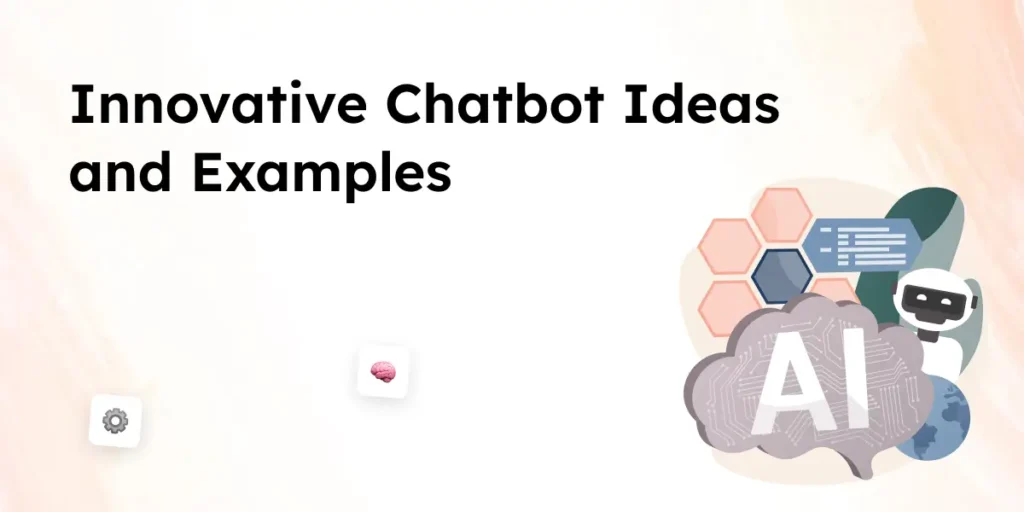A well-designed chatbot enhances customer service, improves user experience, and streamlines interactions. Businesses use chatbots to handle inquiries, automate tasks, and provide conversational support, but poor chatbot design can lead to user frustration and low engagement.
A chatbot must be intuitive, responsive, and aligned with user needs. The right chatbot strategy and best practices will help create a chatbot that improves customer satisfaction while ensuring smooth chatbot interactions.
This guide covers chatbot design best practices, layout guidelines, and real-world examples to help businesses design chatbots that deliver a seamless and engaging chatbot experience.
Understanding Chatbot Design
Chatbot design is the process of structuring chatbot interactions to ensure smooth and engaging conversations. A well-designed chatbot helps users navigate tasks efficiently while maintaining a natural and conversational tone. Whether for customer service, sales, or engagement, chatbot ux plays a crucial role in delivering a positive user experience.
A chatbot must align with business goals and user expectations. This requires considering key elements such as chatbot architecture, conversational flow, and bot design. A successful chatbot is intuitive, providing clear responses while adapting to different queries. The chatbot’s effectiveness depends on how well it guides users through interactions without causing confusion.
Key components of chatbot design include:
- User experience of chatbots: The chatbot should be easy to use, providing clear options and guiding users through conversations smoothly.
- Conversational interface: The chatbot must mimic human-like interactions while ensuring responses remain accurate and relevant.
- Chatbot ux best practices: A chatbot should offer quick, precise responses while allowing flexibility in conversation paths.
- Chatbot platform selection: The right chatbot platform determines how scalable and customizable the chatbot will be.
- Chatbot technology: Advanced ai and generative ai improve chatbot responses, making interactions more natural and engaging.
An effective chatbot strategy includes chatbot implementation that prioritizes ease of use, personalization, and automation. Chatbot analytics also play a role in refining performance, ensuring that the chatbot meets business needs while improving customer experience.
Best Practices in Chatbot Design
Creating a great chatbot requires careful planning and execution. A chatbot must provide smooth interactions, maintain a conversational tone, and align with user expectations. Following chatbot best practices will help businesses build an effective chatbot that enhances user experience and improves customer satisfaction.
Clarify the Chatbot’s Purpose
Before chatbot implementation, define its role. Whether it is for customer service chatbots, lead generation, or internal support, a chatbot must have a clear objective. A chatbot that meets business goals and user needs will deliver better engagement and results.
Choose the Right Type of Chatbot
Different chatbot platforms offer various capabilities. Businesses can use rule-based chatbots for structured workflows or ai chatbots powered by generative ai for more dynamic conversations. Selecting the right chatbot depends on the complexity of the queries it needs to handle.
Design Intuitive User Flows
A chatbot must guide users smoothly through interactions. The chatbot ux should be simple, ensuring users do not feel lost in the conversation. Using buttons, quick replies, and structured menus improves chatbot interactions while reducing frustration.
Define Personality and Tone
A chatbot’s personality should reflect the brand. A conversational ai chatbot that maintains a consistent tone enhances the chatbot experience. Whether formal or casual, the chatbot must provide responses that feel natural and personalized.
Plan for Misunderstandings and Errors
Even the best chatbot cannot answer everything. Implementing fallback responses, providing alternative suggestions, and allowing escalation to a human agent improve chatbot usability. A chatbot can’t be perfect, but it should always offer a helpful next step.
Optimize for Multiple Platforms
Chatbots work across websites, social media, and messaging apps. Ensuring that a chatbot can send responses across different channels enhances accessibility. The chatbot design process should consider various user touchpoints to maximize engagement.
Personalize Interactions
A chatbot helps improve customer experience by using customer data to deliver personalized responses. Implementing a chatbot that adapts to user preferences makes conversations feel more relevant. Personalization also increases engagement and customer satisfaction.
Track Chatbot Performance
Monitoring chatbot analytics is crucial for improvement. Businesses should test the chatbot regularly, tracking chatbot kpis such as engagement rates, response accuracy, and resolution times. A chatbot that continuously evolves will provide better service over time.
Layout Guidelines for Chatbot Interfaces
A well-structured chatbot interface improves the chatbot experience by making interactions smoother and more engaging. A chatbot must have a clear layout that enhances usability and ensures users can navigate conversations without confusion.
User-Friendly Interface Design
A chatbot requires a simple and clean interface. Cluttered chatbot design can overwhelm users, making it harder to interact with the bot. Businesses should focus on clarity by using well-spaced text, quick reply buttons, and structured options. A chatbot must also ensure users can easily restart conversations or return to previous steps when needed.
Incorporating Visual Elements
A chatbot can send images, videos, and gifs to make interactions more engaging. Chatbot interactions that include visual aids improve understanding and keep users engaged. However, the chatbot design process should ensure visuals enhance, rather than clutter, the experience.
Mobile Compatibility
A chatbot must work seamlessly on mobile devices. Many users interact with chatbots through smartphones, so chatbot ux should prioritize responsive design. A chatbot platform that optimizes text display, button size, and input fields for mobile ensures a better experience across all devices.
Accessibility Considerations
A chatbot needs to be accessible to all users, including those with disabilities. Implementing chatbot best practices will help create chatbots that support screen readers, allow for text resizing, and use clear, easy-to-read fonts. Businesses must consider accessibility to ensure everyone can interact with chatbots effectively.
Optimizing Conversational Flow
A chatbot should not overwhelm users with long blocks of text. The chatbot design process must break messages into smaller chunks, allowing for a more natural conversational interface. Using a mix of text, buttons, and quick replies ensures chatbot conversations remain fluid and user-friendly.
Interactive Elements for Engagement
A chatbot might include buttons, carousels, or embedded forms to guide users effectively. These elements into chatbot design simplify user input and improve the chatbot ux. Interactive elements also help users find relevant information faster without typing long responses.
Ensuring Fast Response Times
A chatbot can’t make users wait too long for replies. Chatbot technology should prioritize speed, ensuring messages appear quickly. If a chatbot requires time to process requests, adding typing indicators can improve chatbot interactions and keep users engaged.
By following these chatbot layout guidelines, businesses can create a chatbot interface that improves chatbot usability and engagement. Next, we will explore real-world examples of successful chatbot designs and what makes them effective.
Examples of Effective Chatbot Designs
Real-world chatbot examples provide valuable insights into what makes a chatbot successful. A well-designed chatbot helps businesses improve customer experience, increase engagement, and automate tasks efficiently. Below are three examples of businesses that have used chatbot best practices to create an engaging and effective chatbot.
Converzation AI
Converzation AI is an AI chatbot platform designed to help businesses create conversational interfaces that enhance customer engagement and streamline interactions.
What Makes It Effective:
- User-Friendly Interface: Offers a no-code chatbot builder, enabling businesses to design and deploy chatbots without extensive technical expertise.
- Omnichannel Support: Integrates seamlessly across various platforms, including websites, social media, and messaging apps, ensuring consistent customer experiences.
- Advanced AI Capabilities: Utilizes natural language processing to understand and respond to customer queries accurately, providing a human-like conversational experience.
- Analytics and Reporting: Provides detailed insights into chatbot interactions, allowing businesses to monitor performance and optimize their chatbot strategy effectively.
Eva AI by Desku
Eva AI, developed by Desku, is an AI-powered chatbot designed to revolutionize customer service by providing accurate and efficient support.
What Makes It Effective:
- Seamless Integration: Syncs effortlessly with Desku’s suite, including inbox, ticketing, and analytics, ensuring a unified experience for both teams and customers.
- Quick Setup: Activates in minutes by connecting to existing help centers or online sources, eliminating the need for extensive training or setup.
- Multilingual Support: Automatically detects and responds in the customer’s language, handling queries in any language supported by Desku.
- Human Handoff Capability: Identifies complex issues and seamlessly transfers them to human support agents, ensuring customers receive high-quality service when needed.
Both Converzation AI and Eva AI by Desku exemplify how AI-powered chatbots can enhance customer service and engagement through intelligent design and seamless integration.
Drift
Drift is known for its conversational AI chatbot designed to streamline lead generation and sales. This chatbot helps businesses by qualifying leads in real time and directing them to the right chatbot workflow.
What Makes It Effective:
- Uses chatbot analytics to track user interactions and refine responses.
- Provides a conversational interface that feels natural and engaging.
- Allows seamless handoff to a human agent when needed.
- Personalizes conversations based on user behavior and preferences.
Tidio
Tidio offers an AI chatbot tool powered by chatbot technology that assists businesses in automating customer support. This chatbot improves customer service by providing instant responses to inquiries and guiding users to helpful resources.
What Makes It Effective:
- Uses chatbot kpis to measure engagement and response effectiveness.
- Offers a chatbot platform that integrates with websites and social media.
- Implements chatbot ux best practices by keeping interactions simple and intuitive.
- Includes chatbot search functionality to help users find relevant answers quickly.
Landbot
Landbot focuses on chatbot design for businesses that want to create chatbots without extensive coding knowledge. Its drag-and-drop chatbot creation interface makes it easy for businesses to implement an intelligent chatbot that aligns with their needs.
What Makes It Effective:
- Allows businesses to design a chatbot with a visual interface.
- Helps users interact with chatbots through rich media elements.
- Uses chatbot tool powered by chatbot workflows to ensure seamless user experience.
- Provides chatbot solutions that are customizable for different industries.
Each of these chatbots demonstrates how chatbot development and chatbot implementation can enhance customer satisfaction and business efficiency. In the next section, we’ll explore tools and platforms that businesses can use to create their chatbot with ease.
Testing and Optimization
A chatbot must be continuously tested and optimized to ensure smooth chatbot interactions and an effective chatbot strategy. A chatbot that meets business goals and provides a great chatbot experience requires regular improvements based on user behavior and chatbot analytics.
Importance of User Testing
Before full chatbot implementation, businesses should test the chatbot to identify issues in chatbot ux and conversational flow. Testing helps refine chatbot responses, ensuring the chatbot provides accurate and relevant information.
Ways to test your chatbot:
- Conduct beta testing with a small user group to gather feedback.
- Simulate real-world chatbot conversations to check for gaps in understanding.
- Test chatbot search functionality to ensure users find relevant information easily.
- Analyze chatbot analytics to track performance metrics and identify areas for improvement.
Key Metrics to Monitor
Chatbot kpis help businesses measure the effectiveness of the bot and determine whether their chatbot strategy and deliver results align with expectations. Some key chatbot kpis include:
- Engagement Rate: Measures how often users interact with the chatbot.
- Resolution Time: Tracks how quickly the chatbot can resolve user queries.
- Drop-off Rate: Identifies where users abandon chatbot conversations.
- Escalation Rate: Monitors how often the chatbot hands off to a human agent.
- User Satisfaction Score: Evaluates how helpful the chatbot is based on user feedback.
Continuous Improvement Strategies
A chatbot can’t remain static; regular updates and optimizations are necessary for long-term success. Businesses should:
- Use chatbot analytics to refine responses based on common chatbot interactions.
- Implement ai chatbot tool powered by chatbot data to improve personalization.
- Adjust chatbot ux based on real user feedback.
- Update chatbot responses to reflect changes in products, services, or FAQs.
By optimizing chatbot design and chatbot architecture, businesses can ensure their chatbot solution remains effective and relevant. In the next section, we will summarize key takeaways and provide final thoughts on chatbot implementation.
Conclusion
A well-designed chatbot enhances user experience, streamlines interactions, and improves customer satisfaction. Businesses should focus on chatbot strategy, conversational design, and continuous optimization to create a chatbot that meets user needs. By following chatbot best practices and using the right chatbot platform, businesses can build an effective chatbot that delivers seamless and engaging interactions.
FAQs
1. What is the most important element of chatbot design?
A chatbot must provide clear, structured interactions that guide users naturally. Chatbot ux, conversational flow, and chatbot architecture are key factors in ensuring a smooth user experience.
2. How can I make my chatbot more conversational?
Using conversational ai, natural language processing, and chatbot best practices will help create a chatbot that mimics human-like interactions. Keeping responses short, relevant, and engaging improves chatbot conversations.
3. What are chatbot kpis to measure performance?
Key chatbot kpis include engagement rate, resolution time, escalation rate, and customer satisfaction scores. These metrics help businesses track chatbot effectiveness and identify areas for improvement.



